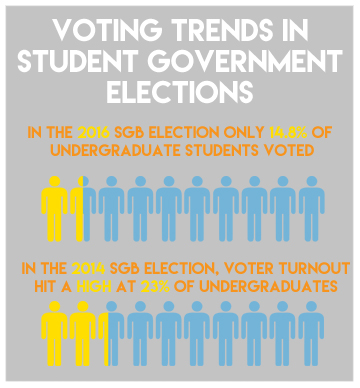It’s that time of year again: A high number of electable candidates running for Student Government Board contrasts with strikingly low interest in the race from Pitt students.
When a student casts a vote in the SGB elections, they’re making an important choice: selecting the person who’s going to be their voice to the administration. Unfortunately, not many students are taking the opportunity to participate in the process.
College-aged millennials’ political behavior in the past few years has leaned toward apathy and non-participation — usually with adverse effects. In last fall’s national elections, voters under 30 showed a clear preference for Hillary Clinton, with majorities in 42 states backing the Democratic ticket. Yet faltering turnout among young voters, particularly in swing states like Pennsylvania, all but handed victory to the Republican Party.
Turnout in the presidential election was poor — but it was nothing compared to the lack of interest students showed in last year’s SGB elections.
Out of the 18,296 undergraduate students at Pitt during the 2015-2016 academic year, only 2,636 voted in the 2016 elections — a mere 14.8 percent of the student body. The highest voter turnout in recent years was in 2014 with 4,127 votes cast, making up about 23 percent of students. These levels of participation are far too low to reflect a truly comprehensive account of what the student body wants to see in its leadership.
Cassidee Knott, RSA secretary for Panther Hall in charge of encouraging student participation in her residence hall, explained that students typically don’t know — and don’t care — about politics on campus.
“People aren’t really educated when it comes to things like elections and the entire process,” Knott said. “They don’t vote unless their rights are in trouble.”
Low voter turnout rates for SGB elections each year reflect a strong indifference among the student body. It’s difficult to determine who really is to blame for the apathy — the students or the campaigning process. It’s probably a bit of both.
For many students, SGB campaigns can feel repetitive, distant and unimportant. Students rarely get a chance to interact with the candidates outside of campaign literature on campus or on Facebook. The SGB presidential debate, held last Wednesday, is the only public and official event where students can see the candidates speaking about issues. And of course, attendance for the event is typically feeble at best — fewer than 50 students came to watch this year.
While SGB campaigns already aren’t particularly long, the shortening of the process this year by one week was a new move.
“The four-week campaigning period last year was overwhelming and draining to the candidates running, and voter turnout was lower than the previous year’s three-week campaigning period, said SGB Elections Chairwoman Julia Lee. “We shortened it by a week this year to make the process less exhausting for our candidates.”
While shorter campaigns likely help the candidates running, three weeks is simply not long enough for voters to get to know the candidates’ intentions and policies. By the time a student realizes they should probably look into who is running and make a choice, it’s already election day and they’re being swayed by whichever campaign has reached them first with a smile, a piece of candy and a reminder to vote for their candidate.
Students generally don’t have the time to invest in elections — school, extracurriculars and social life often all take precedent over informing ourselves about the candidates and the issues. Plus, it’s easy to be indifferent to the entire election process when students don’t see the result as something that directly affects them.
This is partly our fault as students — we should be informed and excited to decide which of our peers will lead us. But it’s also on the candidates and the Board to do more to engage students.
Increased social media presence and accessibility could help students see what SGB really does and advocate for their concerns. Even this year’s presidential candidates themselves recognize that they need to push more thoroughly for student participation outside dominant social circles. If candidates spend more time interacting with students, advertizing their platforms and issues, they can touch students on a more personal level and are more likely to impact their vote.
Reaching out to a large number of students and organizations on campus clearly paid dividends for Natalie Dall, current SGB president, who won the presidency last year with 65 percent of the vote.
“My slate and I reached out to over 100 organizations both times I ran for SGB and we would go to as many meetings possible for the organizations that responded,” Dall said.
Of course, no matter how a campaign plays out, individual students are the ones who have to actively contribute and cast a ballot in the end.
So log on to your my.pitt page today and click the link to cast your votes. If you need information on the candidates, each slate has a weebly website – or you can check out TPN’s SGB voting guide online.


